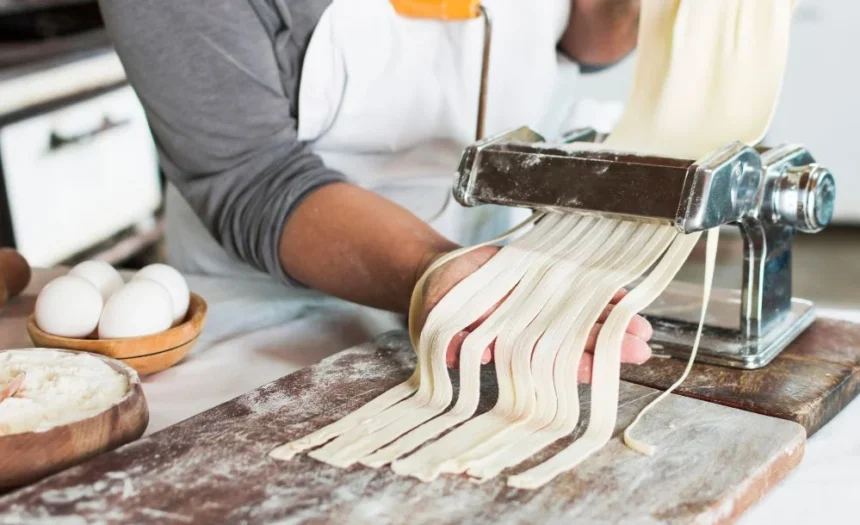If you’ve ever marveled at tortellinatrice the delicate folds of a perfect tortellini, you’re not alone. Pasta lovers everywhere admire the craftsmanship that goes into this traditional Italian delicacy. But behind the curtain of many kitchensboth home and professionalsits an unsung hero: the tortellinatrice. This incredible machine has revolutionized how chefs approach pasta-making, combining efficiency with tradition.
What is a Tortellinatrice?
A tortellinatrice is a specialized kitchen device designed to automate the process of shaping and folding tortellini. Whether it’s a manual crank model or a high-end electric unit, the main goal remains the sameproduce consistent, high-quality tortellini at a faster rate than doing it by hand. It’s a favorite among Italian grandmothers and Michelin-starred chefs alike.
Origin of Tortellini
Tortellini has a long and romantic history deeply rooted in Italian tradition. These small, ring-shaped pasta pieces hail from the heart of Italy, specifically the Emilia-Romagna region. Cities like Bologna and Modena proudly claim to be the birthplace of tortellini, and their cultural rivalry has even led to disputes over the original recipe. One legendary tale tells of an innkeeper who caught a glimpse of Venus, the goddess of love, through a keyhole and was so inspired by the beauty of her navel that he shaped the pasta in her likeness. Regardless of myth, tortellini became a cherished staple of Italian cuisine, often filled with meats, cheeses, or vegetables and served in brodo (broth).
The Manual Beginnings
Originally, tortellini were crafted entirely by hand. Generations of Italian nonnas passed down the technique, carefully preparing the pasta dough, cutting it into squares, placing just the right amount of filling, and folding it into the signature ring shape. This meticulous process was revered as an art form and could take hours or even days to complete for large feasts. The ritual of making tortellini became a symbol of family, patience, and pride.
Industrial Revolution and Pasta Innovation
As demand for pasta grew beyond household kitchens and local trattorias, the need for efficient production became evident. The Industrial Revolution gave rise to pasta machinery, starting with basic rollers and cutters for spaghetti and tagliatelle. Over time, engineers and culinary innovators began to experiment with machines that could replicate more complex pasta shapes.
Birth of the Tortellinatrice
The tortellini was developed as a solution to meet rising commercial demand while maintaining traditional shapes and integrity. It was designed to automate the most labor-intensive parts of tortellini-making: precise folding, shaping, and sealing. Early versions were mechanical and hand-powered, often used in small pasta shops. These machines helped small businesses increase their output while preserving the hand-crafted appeal of their products.
Modern Advancements
With technological advances, tortellinatrice machines evolved into sophisticated electric models with programmable settings. Today, they can shape hundreds or even thousands of tortellini in a fraction of the time it would take by hand. Despite the automation, these machines are carefully engineered to mimic the folding style and gentle pressure of human hands. High-end models are often used by artisan pasta producers, gourmet restaurants, and food factories across the globe.
Blending Tradition with Innovation
The development of the tortellinatrice represents a harmonious blend of tradition and innovation. While it offers a modern solution to a classic culinary challenge, it still pays homage to the artistry of traditional tortellini. In Italy, many families continue to use manual tortellini machines during the holidays, bridging the past with the present in a truly delicious way.
Why the Tortellinatrice Matters in Modern Kitchens
Making tortellini by hand is a labor-intensive job. The tortellinatrice cuts this time drastically. A process that might take hours for a batch can now be done in minutes, freeing up time for other culinary creations.
Uniformity and Precision in Pasta Making
Another reason the tortellinatrice is so revered is its precision. Each tortellino comes out identical in size and shape, ensuring a beautiful presentation and even cooking.
Manual vs. Electric Tortellinatrice
When it comes to making fresh tortellini at home or in a restaurant kitchen, the tortellini is the star tool. But choosing between a manual and an electric model can be a little overwhelming if you’re not sure what to look for. Both versions come with their own advantages and serve slightly different needs. Let’s break down the differences so you can choose the one that best fits your kitchen and workflow.
Pros and Cons of Manual Models
Manual tortellinatrice models offer a traditional experience and more control over the pasta. They’re also generally more affordable and easier to clean. However, they require more effort and aren’t ideal for large batches.
Benefits of Electric Machines
Electric tortellinatrice models bring automation to the next level. With minimal effort, you can produce hundreds of tortellini in an hour. They’re perfect for restaurants or anyone hosting a large gathering.
Materials Used in Tortellinatrice Manufacturing
The Tortellinatrice, whether manual or electric, is a precision tool built for consistent, high-quality pasta production. Its performance, durability, and safety largely depend on the materials used during its manufacturing. Let’s explore the most common materials involved and how each contributes to the machine’s overall function.
Stainless Steel
High-quality tortellinatrice machines are often made of stainless steel, known for its durability, resistance to rust, and easy cleaning.
Food-Grade Plastics and Non-Stick Options
Some models use BPA-free plastics or incorporate non-stick surfaces. While these might not be as long-lasting as stainless steel, they are lighter and often more affordable.
How to Use a Tortellinatrice Step-by-Step
Using a tortellinatrice is simpler than you might think. Start with fresh pasta sheets and your filling of choice. Feed the pasta into the machine, and it does the rest placing the filling, folding, and sealing each tortellino with consistent quality. It’s like having an extra pair of expert hands in your kitchen.
Cleaning and Maintenance Tips
To ensure your tortellinatrice lasts, clean it after every use. Avoid using water on manual metal partswipe them with a dry cloth instead. For electric models, unplug and carefully remove any residual dough. Some parts may be dishwasher-safe, but always consult the manual.
Choosing the Right Tortellinatrice for Your Needs
Selecting the perfect tortellini whether for home use or professional kitchens comes down to understanding your personal cooking habits, batch sizes, kitchen space, and budget. With various models available, from simple manual rollers to fully electric commercial machines, it’s important to weigh the key factors before making a decision.
Domestic vs. Commercial Use
If you’re a home cook, a compact, manual it will likely suit your needs. But for those in the food industry, a commercial-grade machine is a better investment due to its speed and capacity.
Size and Capacity Considerations
Think about how much pasta you plan to make. A small family dinner doesn’t require the same output as a restaurant serving dozens of customers daily.
Common Mistakes to Avoid When Using a Tortellinatrice
A few common errors include overfilling, using overly wet pasta, or feeding uneven sheets into the machine. These can cause the machine to jam or the tortellini to tear. Understanding your specific tortellinatrice model is key to avoiding frustration.
Enhancing Your Culinary Experience with a Tortellinatrice
There’s something magical about homemade tortellini. With a tortellinatrice, that magic becomes accessible to everyone, regardless of skill level. It brings families together, adds excitement to dinner parties, and opens up endless flavor possibilities from classic meat fillings to modern veggie or seafood twists.
Price Range and Where to Buy
The cost of a tortellinatrice can vary widely. Manual models may start around $50, while high-end electric models can go up to $2,000 or more. Popular retailers include Amazon, specialty kitchen stores, and direct manufacturers in Italy for authentic builds.
Expert Tips for Perfect Tortellini Every Time
Make sure your dough isn’t too thick or too thin. Use fillings that hold their shape and aren’t too moist. Practice patience; like any tool, mastering your it comes with time and experience.
Tortellinatrice in Italian Culinary Culture
In Italy, food is more than sustenanceit’s an art form. The tortellini embodies this ethos. It doesn’t replace tradition; it enhances it. From family kitchens to professional pasta labs, it plays a vital role in preserving the joy of handmade tortellini.
The Future of Pasta-Making Machines
Innovation doesn’t rest. Future tortellinatrice models may include smart featuresAI-controlled filling amounts, touch-screen interfaces, and even app connectivity. Imagine customizing your tortellini recipe with a few taps on your phone!
Conclusion
The tortellinatrice is more than just a machineit’s a gateway to culinary creativity, efficiency, and joy. Whether you’re a seasoned chef or a curious beginner, this tool makes one of Italy’s most cherished dishes accessible to all. From family gatherings to fine dining, having a tortellinatrice in your kitchen can transform your pasta game. Embrace tradition, elevate your skills, and let your tortellini speak for themselves.



